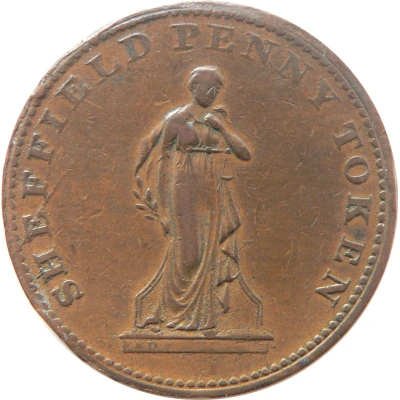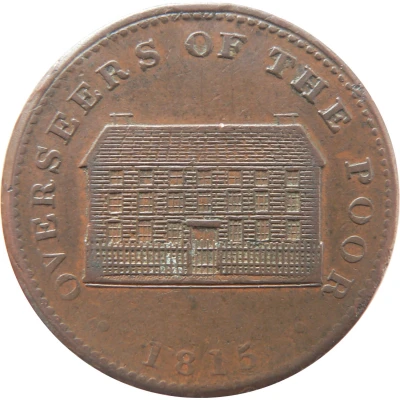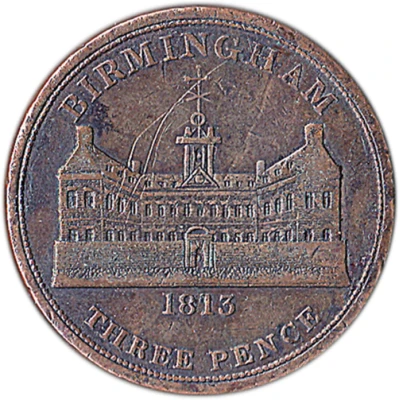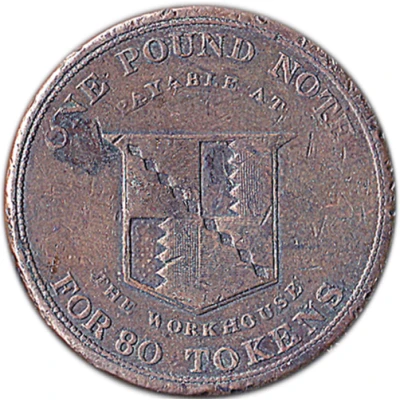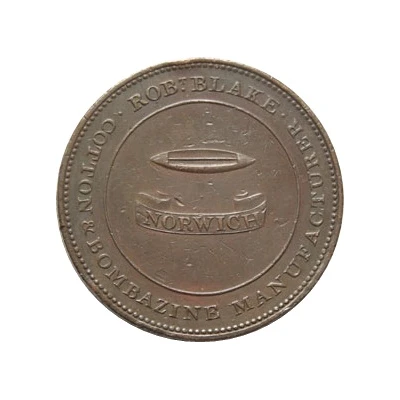
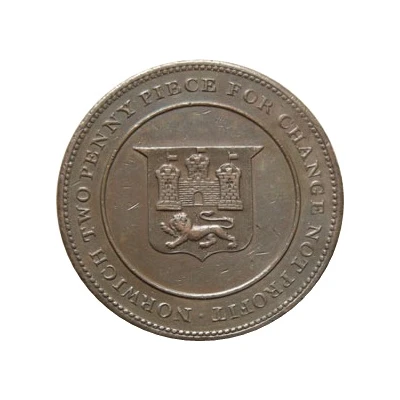

© ABC Coins & Tokens
2 Pence Norwich - Robert Blake ND
| Copper | 44.1 g | 41 mm |
| Issuer | United Kingdom (United Kingdom, British Overseas Territories and Crown Dependencies) |
|---|---|
| Type | Token |
| Years | 1811-1815 |
| Value | 2 Pence (1⁄120) |
| Currency | Currency tokens (1798-1816) |
| Composition | Copper |
| Weight | 44.1 g |
| Diameter | 41 mm |
| Thickness | 4 mm |
| Shape | Round |
| Technique | Milled |
| Orientation | Coin alignment ↑↓ |
| Demonetized | Yes |
| Updated | 2024-10-09 |
| Numista | N#81715 |
|---|---|
| Rarity index | 73% |
Reverse
The Arms of the City of Norwich in centre circle, consisting of a lion beneath a triple-turreted castle gateway. Lettering around, beaded border
Script: Latin
Lettering: NORWICH TWO PENNY PIECE FOR CHANGE NOT PROFIT ·
Edge
Diagonal centre milling
Comment
Robert Blake's Norwich (Norfolk) copper 'cartwheel' twopence token undated (though may be around 1812 date). Manufactured (by Boulton) some time in the early 19th Century before 1815. The phrase 'For Change Not Profit' is indicative of the nature of the change shortage, as tokens were sometimes struck at a loss to the issuer, because the lack of money to facilitate trade was a more serious issue for merchants and traders to contend with than the trouble and expense of having strike their own money. Generally speaking, the larger a coin, the cheaper it was to strike the coin relative to its face value. No doubt this was one of the reasons for striking such an unusually large token.Robert Blake's business was in Heigham Street, Norwich. He was a cotton-maker, bleacher, bombazine, crape and shawl manufacturer. Quality bombazine is made with a silk warp and a worsted weft. It is twilled or corded and used for dress-material.
The causes of the resumption of copper token coinage in the early years of the nineteenth century are complex. Certainly, public concern over the outcome of the Napoleonic Wars (whose course reached a climax of intensity after 1810) played a part, for it encouraged a hoarding of all coinage, copper included. But there was more to it than that. Industrial production related to the war effort also reached a crescendo during these years, which naturally meant that an increasing number of coins would be required for wages. Under ordinary circumstances, the excellent pieces supplied by Boulton & Watt between 1797 and 1807 should have been adequate to the demand. Unfortunately, the price of copper began to rise at the turn of the century. This had the effect of removing the heavy Boulton & Watt regal issues of 1797 and 1799 from circulation. The massive Parys Mine tokens likewise disappeared - it had become profitable to melt down all these pieces for scrap. The later, somewhat lighter regal issues of 1806-1807 were not so affected (indeed, their lighter weight was a reflection of the rise in copper prices just mentioned), but they were not in themselves adequate to meet the burgeoning needs of the period.
Textile manufacturing is represented on nineteenth-century coppers - not to the degree that one might expect, but fairly prominently all the same. The woolen and worsted industries are recalled on an 1811 penny from Norwich and an undated piece from Lichfield, Staffordshire, respectively. The Lichfield token was massive, a twopenny one. A second Norwich textile manufacturer, Robert Blake, specialized in cotton and bombazine. His rather scarce twopenny features the Norwich arms on the obverse, a shuttle on the reverse, as an indication of his trade. The Blake piece was probably struck in 1811, although it does not bear a date.
Interesting fact
One interesting fact about the Token 2 Pence (Norwich - Robert Blake) ND (1811-1815) coin is that it was issued during a time of severe currency shortages in the United Kingdom, particularly in the eastern counties of England. The coin was minted by Robert Blake, a merchant in Norwich, as a private token, which was a common practice during this period. The coin's design features a crowned shield with the initials "RB" (for Robert Blake) on the obverse, and a Britannia figure on the reverse. Despite being made of copper, the coin was valued at 2 pence, which was a relatively high denomination for a token coin at the time. Today, this coin is considered a rare and valuable collector's item, with some examples selling for hundreds of pounds at auction.
Price
| Date | Mintage | VG | F | VF | XF | AU | UNC |
|---|---|---|---|---|---|---|---|
| ND (1811-1815) | - | - | - | - | - | - |
Values in the table are based on evaluations by sales realized on Internet platforms. They serve as an indication only for 2 Pence (Norwich - Robert Blake) ND (1811-1815) coin.
